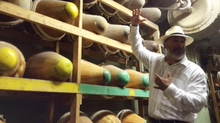Real Tech Talent Is Hiding in Plain Sight

It often takes a college degree, or at least more high-tech certifications, to program and maintain things like industrial 3D printers, robotics, and other workplace automation machines.
This is where it makes sense for companies to actually pay for the training and education of their employees. Rather than conduct a six-month search for someone to manage your company’s robots, why not train a couple of your employees? This will not only make the search easier — just ask your floor managers who would be able to handle that kind of responsibility — but you can make paying for their education a part of their work requirements. For example, offer to pay for their education for two years if they commit to staying with the company for another four.
In Anthony Bourdain’s book, Kitchen Confidential, Bourdain talks about his old boss, Bigfoot, and how he avoided paying for expensive repairs on the various equipment. He had trained several porters to perform repairs on different areas around the kitchen. Whenever there was a problem, Bigfoot would send his porters to fix it, rather than wait for a third-party tech to show up two days later and charge $500 to fix it. Bourdain said this crew was "... a Presidential Guard of blue-uniformed porters whom he had personally trained in the manly arts of refrigeration repair, plumbing, basic metal work, glazing, electrical repair and maintenance. In addition to the usual tasks of cleaning, mopping, toilet-plunging and porter work, Bigfoot porters could lay tile, dig out a foundation, build you a lovely armoire or restore a used reach-in refrigerator to factory specs.”
So, following this logic, the best people to hire to program and maintain your high-tech machines may well be the people who are already operating them.
It was always my philosophy that the people who operated machinery should be involved in the design, implementation, and operations of those machines so that it was a continuous learning process. The more they learned, the better they could make the machine work, and the more problems they could fix. So why not take the best of those associates and give them the training to make them even better?
The individuals actually get a sense of ownership because their opinion in terms of the machine’s design, its operation, and even its safe use, is highly valuable. Interestingly, the operators in your workplace already know all this stuff and they will know more about it than management. And if you have custom machines, or off-the-shelf machines that have been changed and updated to fit your particular needs, you can’t bring in an outsider who will know as much or more than your crew.
Oftentimes, we included the operators in the planning and execution of projects and sent them to the vendors to prove out the equipment and be fully trained before we took delivery of it. This did indeed create a sense of ownership on the part of our associates and also helped in creating “bench strength.”
That means if you involve them in the development and implementation, you actually get a two-fer: you get a more committed individual, but he or she is on a continuous learning curve.
So, if workers are going to be displaced, incorporate them into the future so you don’t have to displace all of them. Of course, you will still end up with an excess number of workers, but natural attrition will help solve that problem for you ultimately. And selecting the best and brightest from among your pool of workers will help your company run better, more efficiently, and ultimately, more profitably, and it will help shore up the skilled labor shortage in this country.
EndFragment





















